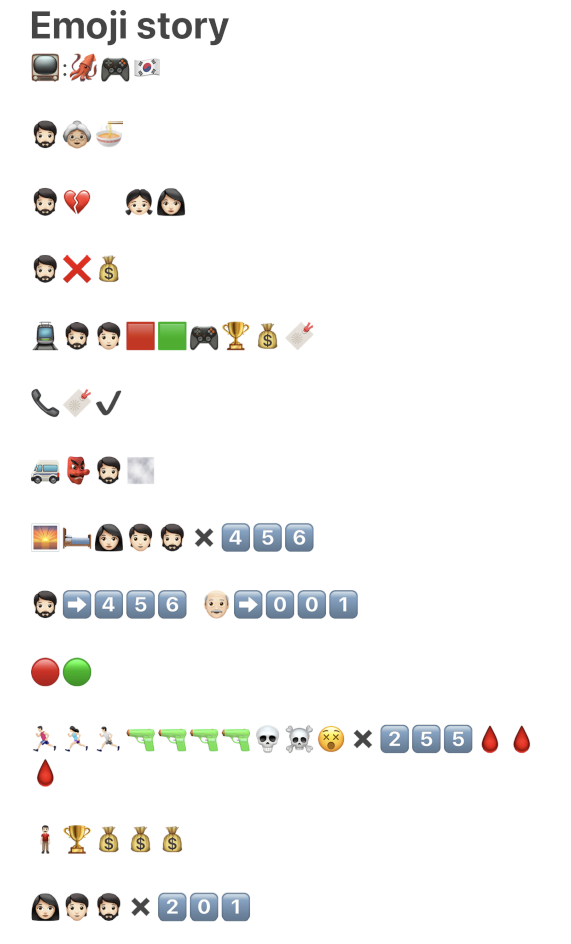This week’s task encouraged us to create an emoji story based on a recent movie, television show, or book. If you are following trends right now, you will know exactly the story I am portraying. Below is episode one:

This process was fun yet challenging. I wanted to focus on the main ideas and plot of this episode and I believe I captured them quite nicely from the available emojis. I started with the title as it seemed easy to figure out. I decided to also add a flag so that readers could understand where the show was filmed and in what language. Throughout telling the emoji story, I focused more on ideas and what would best capture the main elements of this episode. I found that focusing on words and syllables became lengthy and was not effective and conveying the plot. When using the emojis for ideas, readers are able to explore their creative thoughts to figure out the representation.
I wanted to make sure that I captured the characters as best as I could, however, not all nationalities are represented in the emojis. I also noticed that within emojis there are not any families that are biracial or any that represent a step mom or step dad.
There are also many emojis that are not included in the available selection, such as a real guns, dead bodies, a business card, sleeping gas, different clothing options, facial masks, and other objects.
What I really enjoyed about creating an emoji story like this is that I did not have to worry about punctuation or spelling. It was all focused on the visual aspect of a story. I did however, split up the main moments of the episode so that readers could obtain a better understanding of what I was trying to represent. For breaks in the moments of the story, I was able to use spaces to signify this.
According to Bolter (2001), he discusses “ekphrasis sets out to rival visual art in words to demonstrate that words can describe vivid scenes without recourse to pictures [, … however the] attempt to make words do what pictures do might be taken to mean that pictures are primary and words secondary” (p. 56). Also, Bolter (2001) states that, “the relationship between popular films and novels is further proof that the visual is now regarded as primary” (p. 56). This is also the case for when students are just starting to learn how to read. In order to read, we must understand what the picture is describing before we are able to understand the meaning of the word. Therefore, I do believe that images come before the text. Bolter (2001) also points out that students who are young are able to “follow the story and become accustomed to the linearity of reading before [they] can actually decipher the letters that constitute alphabetic writing” (p. 54). In my Kindergarten class, students draw out their story before they learn how to write the words. With this task, the emojis allow us to make meaning of a story without using words by focussing on the visual aspect of storytelling. This task and other visual stories, allow for there to be a universal understanding without the need to translate the visual meaning into multiple languages. The visual representations also remind me of IKEA instructions. All of the instructions contain pictures that are universally understood, making the instructions useful for all.
References:
Bolter, J. D. (2001). Chapter 4. Writing space: Computers, hypertext, and the remediation of print(2nd ed.). Mahwah, N.J: Lawrence Erlbaum Associates. doi:10.4324/9781410600110
Hi Stephanie,
You captured the main ideas and elements of Squid Game really well! You’re right, emojis are in a sense like visual elements in technical instruction booklets that speak a universal language.
Hi Steph!
I also did the same show as you. I noticed that we had very different ways of showing the plot of the story. I really liked how you used the numbers to showcase the characters. I didn’t even focus on trying to talk about other characters other than the main protagonist for the fear of confusion. It defiantly was easier to understand your explanation of the plot if you knew the context of it. I noticed we focused on different parts of the plot. That is interesting!